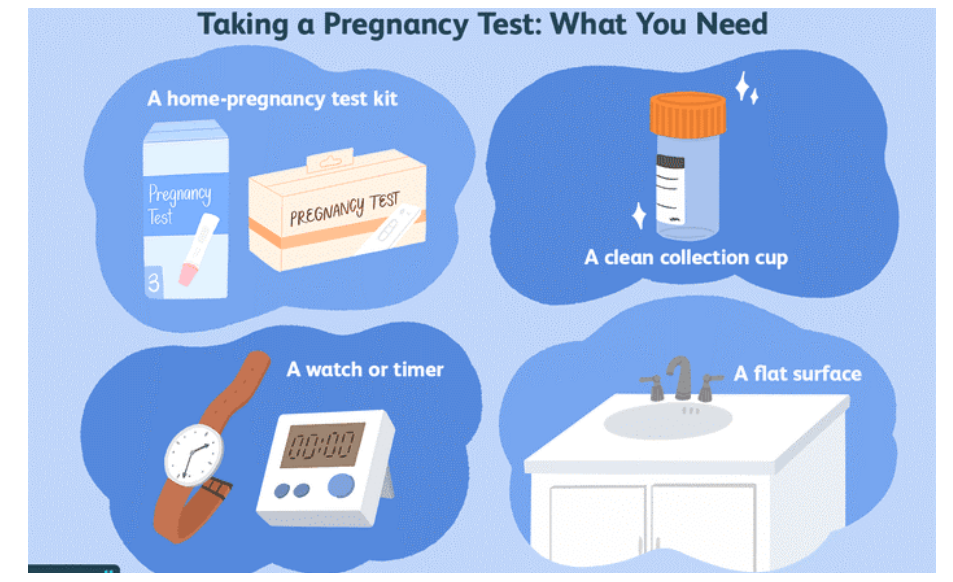How do pregnancy tests work?
Pregnancy tests are an easy and accurate way to find out if you’re pregnant — you just pee on a stick. They’re inexpensive and available at most drug and grocery stores.In Kenya the costs of pregnancy kits is 50/=, and are readily available at a pharmacy
How accurate are pregnancy tests?
Pregnancy tests are super accurate when you use them correctly. The pregnancy tests you get at the drugstore work 99 out of 100 times. They’re just as accurate as a urine pregnancy test that you’d get at a doctor’s office.
Pregnancy tests work by checking your urine (pee) for a hormone called human chorionic gonadotropin (HCG). Your body only makes this hormone if you’re pregnant. HCG is released when a fertilized egg attaches to the lining of your uterus — when pregnancy begins. If your pregnancy test results are positive, it means you’re pregnant. If they’re negative, it means you’re not pregnant.
Pregnancy tests are most accurate when you take them after you’ve already missed your period.
A pregnancy test will be less accurate if it’s expired or if you don’t use it the right way. So always check the expiration date on the package, and carefully read the directions that come with your pregnancy test.
How soon can I take a pregnancy test?
You can take a pregnancy test anytime after your period is late — that’s when they work the best. It’s a good idea to take a pregnancy test as soon as possible if you miss your period or think you might be pregnant.
The earlier you know you’re pregnant, the sooner you can start thinking about your options and get whatever care you need to stay healthy.
Many pregnancy tests say they work a few days before a missed period, but the results are usually less accurate then. Read the label on your pregnancy test to find out when to take a pregnancy test and how accurate it’ll be.
Sometimes a pregnancy test is able to find pregnancy hormones in your urine as early as 10 days after unprotected sex. But these results aren’t super reliable, and you may get a false positive or false negative test result.
If your periods are very irregular, or you don’t get periods at all for one reason or another, your best bet for accurate results is to take a pregnancy test 3 weeks after sex
Where can I get a pregnancy test kit in Kenya?
You can buy a pregnancy test at your local pharmacy, drugstore, grocery store, and some stores. Pregnancy tests are usually inexpensive — they can cost as little as 50 kshs. Sometimes you can get a free pregnancy test at certain health centres e.g mariestopes clinics in Kenya.

How the Tests Work.
Pregnancy tests work by detecting hCG (the pregnancy hormone) in your urine. When a fertilized egg has implanted into your uterus, your body will begin to make hCG. Most home pregnancy tests have about the same ability to detect hCG. This is called their sensitivity — most home tests can detect hCG levels at the 20mIU/hCG (mIU is a level of measurement) — some home pregnancy tests are a little bit more sensitive and others a little less sensitive. Usually, the instructions should tell you the sensitivity levels of the pregnancy test. A home pregnancy test will give you a positive result if your hCG level is 20mIU/hCG at the time that you take the test
When to Use a Test.
A good rule of thumb is to wait at about 21 days (three weeks) after you last had unprotected sex/birth control failure before using a home pregnancy test—or at least one day after a missed period. On average, 20mIU/hCG levels are present about seven to ten days past ovulation. So to quickly review.
- Most women will ovulate 14 or 15 days from the first day of your last menstrual cycle.
- If your egg is not fertilized once you ovulated, then your period should begin about 14 days after ovulation.
- If your egg is fertilized, implantation generally happens around +/- 9 days (average 6-12 days) days after you have ovulated.
- Because implantation must take place in order for hCG to be made, you should wait to use a home pregnancy test until your period is at least one day late.
Before You Use a Test.
Take these steps to get a home pregnancy test and prepare to use it:
- Buy a test from a store or online e.g jumia kenya. When buying a home pregnancy test, some experts suggest that you purchase one from a large store that has a lot of product turnover — this way, you will be more likely to buy a newer test and not one that has been sitting on the shelves for months.
- Check the expiration date on the test and make sure it is still valid. If you have been storing the home pregnancy test for a while, especially in an area like a bathroom (where it gets warm or moist), inspect the test to make sure that it has not deteriorated. If this is the case, you are better off buying a new one and throwing this pregnancy test away.
- When you are ready to test, first read all of the directions carefully (because they may be different for each pregnancy test brand). If you have any questions about how to perform the test or interpret the results, look for a toll-free number in the package instructions. You can call this number to have your questions answered
- For the best accuracy, plan to take the test with your first morning urination. Your urine is more concentrated at this time. So, if you are pregnant, your first morning pee will have a higher amount of hCG in it than pee from later on in the day.
Taking Your Home Pregnancy Test in Kenya.
- Be careful when handling your home pregnancy test.
- Wash your hands with warm water and soap.
- Remove the pregnancy test from its foil wrapper.
- Sit down on the toilet.
- Depending on the particular home pregnancy test, you should pee in a collection cup or pee directly onto the pregnancy test stick. Some tests will give you the option to collect your urine either way. It is important to catch a “midstream sample.” This means that you should let out a little bit of pee first, and then use the rest of your pee for the test.
- a) If the home pregnancy test requires you to pee directly onto the stick — place the side of the test stick with the absorbent tip in your urine stream with the “result window” facing up. Pee on it for about 5-10 seconds (or whatever time it says in the directions).
b) If you have collected your urine in a cup — use the supplied dropper to place a small amount of pee in the testing well. If your test did not provide a dropper but said that you could use a collection cup, dip the absorbent end of the pregnancy test into the cup of pee and hold in place for 5-10 seconds (or whatever time it says in the directions). - Place the pregnancy testing stick on a flat, dry surface with the “result window” facing up.
- The instructions will tell you how many minutes to wait for the results to appear. This can be anywhere from one minute to five minutes — though some home pregnancy tests can take up to 10 minutes to give you an accurate result.
- While the home pregnancy test is checking for the presence of hCG, there will most likely be a “control window.” You will probably see the background in the control window get darker as the urine passes through. Most control windows will display a line or symbol to show that the test is valid. If this control indicator does not appear, chances are very likely that the test is not valid or did not work properly.
- Once the amount of time has passed, you can check the results. The result will usually show up in a separate window (although, in some home pregnancy tests, the result will show up in the same window). Keep in mind that the different tests may display the results differently, so make sure you read in the instructions what shape or symbol you should be looking for. If you are pregnant, examples of shapes/symbols you may see include:
a)A pink or blue line.
b)A red plus or minus sign.
c)A color change in the window or the urine in the test may change color.
d)The words pregnant or not pregnant. - If the home pregnancy test gives you a negative result, but you do not get your period — you should retest in about 3-5 days to make sure that you did not receive a false-negative result. Since the amount of hCG increases rapidly when you are pregnant, you may end up with a positive test if you test a few days later. This is why some home pregnancy test kits come with more than one test — so you have another one to re-test with (in case you took the first pregnancy test too soon).
- If you have taken the home pregnancy test anytime before it has been 7 days since your missed period, do not automatically believe that a negative test result means that you are not pregnant. This is because you may have taken the home pregnancy test too soon. Wait another week — if you still have not gotten your period and are still getting a negative test result, you should make an appointment with your doctor to figure out if something may be going on.
- If you got a positive test result on your home pregnancy test, it is important that you make a medical appointment, so your doctor can confirm the result of your home pregnancy test.
Tips When Taking a Test.
Keep these tips in mind if you decide to use a home pregnancy test:
- One-step home pregnancy tests are typically thought to be the most convenient to use. These tests include dipsticks that can either be quickly held in your urine stream or dipped into a collection cup.
- If any line, symbol, or sign shows up in the results window, no matter how faint, you can consider the home pregnancy test result to be positive. A line will not show up if the test does not detect hCG — so even the faintest line means that the test has picked up on hCG in your pee.
- Your home pregnancy test result is only accurate if you see the symbol/line during the specified amount of time — so if the instructions say to wait 3 minutes, whatever shows up in the “result window” when you waited 3 minutes is your test result. If the pregnancy test sits for too long, an “evaporation” line may appear. If any line, symbol, or sign shows up after the amount of time specified in the instructions, this is not considered to be a positive pregnancy test result.
- You may also want to ask your doctor or pharmacist about medications that could possibly alter the results of a pregnancy test.
- If you have ovulated later in your cycle or did not properly calculate your ovulation date — there is a good chance that you may have taken the pregnancy test too soon to receive a positive test result.

